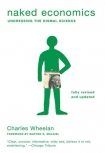Naked Economics, Wheelan, Charles [open ebook .txt] 📗

Book online «Naked Economics, Wheelan, Charles [open ebook .txt] 📗». Author Wheelan, Charles
The business cycle takes a human toll, as the layoffs splashed across the headlines attest. Policymakers are increasingly expected to smooth this business cycle; economists are supposed to tell them how to do it. Government has two tools at its disposal: fiscal policy and monetary policy. The objective of each is the same: to encourage consumers and businesses to begin spending and investing again so that the economy’s capacity no longer sits idle.
Fiscal policy uses the government’s capacity to tax and spend as a lever for prying the economy from reverse into forward. If nervous consumers won’t spend, then the government will do it for them—and that can create a virtuous circle. While consumers are sitting at home with their wallets tucked firmly under the mattress, the government can start to build highways and bridges. Construction workers go back to work; their firms place orders for materials. Cement plants call idled workers back. As the world starts to look like a better place, we feel comfortable making major purchases again. The cycle we described earlier begins to work in reverse. This is the logic of the American Recovery and Reinvestment Act of 2009—the stimulus bill that was the first major piece of legislation under the Obama administration. The Act authorized more than $500 billion in federal spending on things ranging from expanded unemployment benefits to resurfacing the main highway near my house. (There is a big sign on the side of the road telling me that’s where the money came from.)
The government can also stimulate the economy by cutting taxes. The American Recovery and Reinvestment Act did that, too. The final bill had nearly $300 billion in assorted tax cuts and credits. The economic logic is that consumers, finding more money in their paychecks at the end of the month, will decide to spend some of it. Again, this spending can help to break the back of the recession. Purchases generated by the tax cut put workers back on the job, which inspires more spending and confidence, and so on.
The notion that the government can use fiscal policy—spending, tax cuts, or both—to “fine-tune” the economy was the central insight of John Maynard Keynes. There is nothing wrong with the idea. Most economists would concede that, in theory, government has the tools to smooth the business cycle. The problem is that fiscal policy is not made in theory; it’s made in Congress. For fiscal policy to be a successful antidote to recession, three things must happen: (1) Congress and the president must agree to a plan that contains an appropriate remedy; (2) they must pass their plan in a timely manner; and (3) the prescribed remedy must kick in fast. The likelihood of nailing all three of these requirements is slim. Remarkably, in most postwar recessions, Congress did not pass legislation in response to the downturn until after it had ended. In one particularly egregious example, Congress was still passing legislation in May 1977 to deal with the recession that ended in March 1975.16 At the end of the relatively mild 2001–2002 recession, the New York Times ran the following headline: “Fed Chief Sees Decline Over; House Passes Recovery Bill.” I’m not making this stuff up.
What about the Obama stimulus? The American Recovery and Reinvestment Act was seemingly timely, but most of the money was not spent immediately (though there still can be a psychological benefit, and therefore an economic benefit, to simply announcing that lots of spending is coming). Critics of this huge economic intervention argue that it lavished borrowed government money on all kinds of unimaginable projects, some of them quite silly, and will add huge sums to the national debt. Proponents of the stimulus, such as Obama’s chair of the Council of Economic Advisers, Christina Romer, make the case that the $787 billion stimulus raised real GDP growth by 2 to 3 percentage points and saved a million jobs.17 As far as I can tell, they’re both right. I was a congressional candidate at the time, so my views are a matter of public record (for the small number of people who paid attention to them). The economy was caught in dangerous negative feedback loops—foreclosures were causing banking problems which were causing layoffs which were causing foreclosures, and so on. I was fond of saying, “A bad stimulus is better than no stimulus, and a bad stimulus is what we got.” The government needed to do something to break the cycle (in part because monetary policy was not working, as will be explained in a moment). I would have preferred that the government target more of the spending toward infrastructure and human capital investments to improve the long-term productive capacity of the nation. I agree that rising government indebtedness is a problem, as will be discussed in Chapter 11. That said, given the financial panic described earlier in the chapter and the capacity for bad economic events to beget more bad economic events, there is a reasonable argument to be made that even paying people to dig holes and then fill them in would have been a better policy choice than doing nothing.
The second tool at the government’s disposal is monetary policy, which has the potential to affect the economy faster than you can read this paragraph. The chairman of the Federal Reserve can raise or lower short-term interest rates with one phone call. No haggling with Congress; no waiting years for tax cuts. As a result, there is now a consensus among economists that normal business cycles are best managed with monetary policy. The whole next chapter is devoted to the mysterious workings of the Federal Reserve. For now, suffice it





Comments (0)